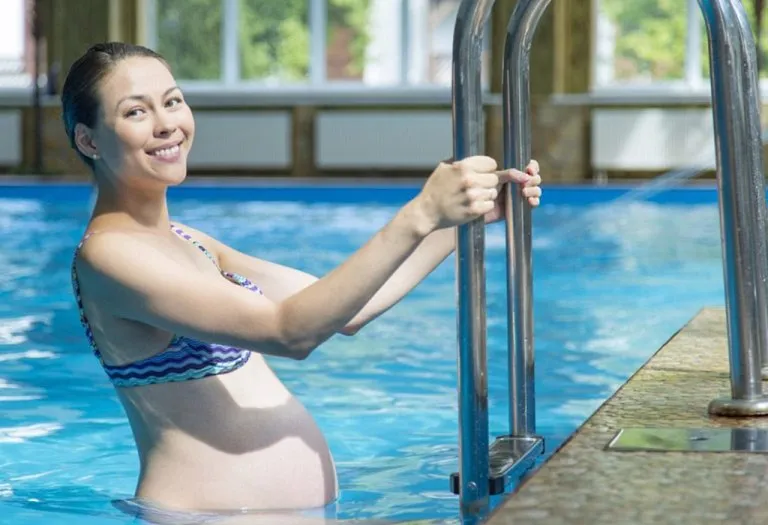Swimming During Pregnancy: Is It Safe? Benefits & Tips

- Can Pregnant Women Swim?
- What to Wear While Swimming?
- Suggested Pregnancy Swimming Workout
- Benefits of Swimming in Pregnancy
- Tips for Swimming While Pregnant
- When Should You Stop Swimming While Pregnant?
- Precautions to Take During Swimming
- FAQs
When you are carrying a new life inside you, exercise is probably the last thing on your mind. But then there are some exercises that can prove to be beneficial during pregnancy. Swimming, for instance, is an exercise that may make you feel light while pregnant. When we enter a pool or any other water body, we only weigh a tenth of our actual weight, and this is something that may work in your favour when you swim while pregnant. However, safety precautions must be taken to ensure a smooth and enjoyable experience in the water. In this article, we will explore the numerous benefits of swimming in pregnancy, essential safety guidelines, and useful tips to make the most of this refreshing and effective workout.
Can Pregnant Women Swim?
Swimming is one of the best exercises for a pregnant woman as it can ease the pains associated with pregnancy. Furthermore, swimming is a highly recommended exercise for pregnant women as it helps maintain their health. That said, if a woman has a complicated pregnancy or if there is a possibility of a high-risk pregnancy, then certain precautionary measures should be taken while swimming, and it should be practised only after checking with a doctor. If you have been doing prenatal swimming, there is no reason for you to not continue, unless advised otherwise by your doctor. It would be challenging to learn swimming during pregnancy though. You should not exert the body beyond its limits and understand how much your body can give in to this exercise (1) (2).
What to Wear While Swimming?
As your stomach expands, your favourite swimsuit will no longer be able to hold you. A two-piece suit gives a lot of space for the growing baby, so you can buy one if you want to swim while pregnant. You can opt for a maternity swimsuit if you are not comfortable flaunting your bloated tummy. Check with your regular swimwear brand for one, as maternity swimwear is quite fashionable.

Suggested Pregnancy Swimming Workout
There are many pregnancy swimming exercises you could try out in the pool. In fact, you should be prepared with a basic workout before you step into the water. Below is a list of pregnancy-friendly swimming exercises to keep you active and energised throughout your journey (3) (4).
For Beginners
If you’re new to swimming or haven’t exercised in a while, pregnancy is a great time to start with gentle water-based workouts. Here are some beginner-friendly swimming exercises to help you ease into a safe and enjoyable routine.
- Stroke and Crawl – Swim one lap using the breaststroke, then swim back using freestyle/crawl to engage different muscle groups.
- Double Backstroke – Swim backstroke, but instead of alternating arms, perform two strokes with one arm before switching to the other.
- Sprint and Slow – Swim one lap at your fastest pace, then return at a slow recovery pace to catch your breath.
- Practice Flutter and Frog Kicks – Hold onto a kickboard and perform flutter kicks for one lap, then use frog kicks on the way back to strengthen your legs.
For Intermediate and Advanced
For those who are already comfortable in the water and want a more structured workout, swimming can be an effective way to maintain strength and endurance during pregnancy. Below are intermediate-to-advanced swimming exercises that help build stamina while keeping you and your baby safe.
- Five Sets of 100 Yards – Swim 100 yards (four laps) at a moderate pace, taking 10–20 seconds of rest between each set. After completing all five, rest for one minute.
- Six Sets of 50 Yards – Swim 50 yards (two laps) with a focus on form. Rest for 20–30 seconds between sets, then take a one-minute break when finished.
- Ten Sets of 100 Yards – Swim 100 yards (four laps) with a focus on speed, aiming for about 80% effort. Rest 10–30 seconds between sets, then take a one-minute break.
- Grab a Kickboard and Do Four Laps – Use a kickboard and swim four laps, relying only on your legs to build endurance and strengthen your lower body.
- Swim Four More Laps at an Easy Pace to Cool Down – Finish with a relaxed swim to lower your heart rate and stretch out your muscles.
Benefits of Swimming in Pregnancy
As mentioned above, swimming is one of the best exercises for a pregnant woman and it can prove to be beneficial for your health during pregnancy. Here’s how swimming may help you while pregnant (2) (3) (4) (5) (6):
- Swimming is the perfect exercise for you to maintain your weight.
- It is a low-impact exercise that can benefit your cardiovascular health.
- Swimming during pregnancy can increase your strength, tone your muscles and improve blood circulation.
- It reduces the stress on the spine and surrounding muscles.
- Swimming helps strengthen the muscles and their functionality around the shoulders and spine.
- It can help you relax during pregnancy.
- Swimming can also improve your sleep quality.
- Swimming is better than other exercises since it is easy on ligaments and joints during pregnancy.
- Swimming reduces pressure on the spine and pelvis, helping to relieve sciatic nerve pain.
Tips for Swimming While Pregnant
Here are a few tips you should following while swimming during pregnancy.
1. Swimming During Pregnancy: First Trimester
During the first trimester, you should ideally swim for 30 minutes every day, provided your doctor approves and you have the strength. Start your day with a swim and your morning nausea will vanish, while improving your overall strength.
2. Swimming During Pregnancy: Second Trimester
As the baby size grows and your body becomes heavier, you may want to reduce the frequency. If your back is acting up, do the backstroke since it will help you lie on your back and won’t affect the blood flow too. Buy a larger and a more accommodating swimsuit if the present one is cramping your swimming style.
3. Swimming During Pregnancy: Third Trimester
If you want to reduce the stress on your back muscles, the breaststroke is the best style to use. It also works on the chest muscles and helps elongate it. Using a snorkel is also a good idea as it helps to relieve neck pressure. Be careful while walking on wet surfaces and use anti-slip footwear.
When Should You Stop Swimming While Pregnant?
If you experience any of the following symptoms, seek help and leave the pool immediately (7):
- Vaginal bleeding
- Pain in the abdomen or lower region
- Uterine contractions
- Dizziness, light-headedness, or breathlessness

Overall, women who have had multiple miscarriages, ruptured membranes or any heart disease should avoid swimming during pregnancy or seek medical advice before starting.
Precautions to Take During Swimming
Swimming is an excellent way to get the much-needed exercise during pregnancy without straining yourself. But you must follow these precautions while swimming (3):
- Make sure you are keeping yourself hydrated enough if you are swimming for 30 minutes or more, by drinking fluids and taking glucose supplements.
- Do not jump or dive into the pool as this could cause harm to you and your baby.
- Avoid swimming if you feel unwell or feel a cold coming as this could aggravate it further
- Swim in pools that have clean water.
- Make sure you are not straining yourself too much, keep in mind that you need to be extra careful with your movements. Maintain a correct posture while swimming during pregnancy.
FAQs
1. How often should pregnant women swim?
If you’re wondering, can a pregnant woman swim, the answer is yes. Swimming is a safe and beneficial exercise during pregnancy. It depends on your fitness level, but swimming 3–4 times a week for 20–30 minutes at a moderate pace is generally recommended. Always listen to your body and avoid overexertion.
2. Can I swim in open water during pregnancy?
Swimming in the ocean while pregnant can be safe if the water is clean and there are no strong currents. Always check for safety conditions, avoid extremely cold water, and be cautious of slippery surfaces when entering and exiting the water (2) (4).
3. Is it safe to swim in cold water during pregnancy?
Swimming in cold water while pregnant is generally safe, but it’s important to be cautious. Sudden exposure to very cold water can cause blood vessels to constrict, affecting circulation and oxygen flow to the baby (3). If you choose to swim in cold water, enter gradually to allow your body to adjust, limit your time in the water, and listen to your body for any signs of discomfort, such as shivering or numbness.
Swimming and pregnancy go well together, as it is a safe and beneficial exercise that helps expectant mothers stay active and comfortable. A relaxing swim in a pleasant environment is much needed to soothe the nerves and calm yourself. Take the right precautions during these sessions to get the most out of it.
References/Resources:
1. PubMed – Is swimming during pregnancy a safe exercise?
2. Tommy’s – Swimming in pregnancy
3. International Forum for Wellbeing In Pregnancy – ANTENATAL SWIMMING
4. Loma Linda University Health – A helpful guide to swimming during pregnancy
5. University of Rochester Medical Center – Keep Cool: Hot-Weather Tips for Pregnant Women
6. Seminars in Perinatology – Water exercise in pregnancy
7. U.S. Masters Swimming – Swimming and Pregnancy
Also Read:
Walking During Pregnancy
Fun Things to do during Pregnant
Household Work To Do & Avoid In Pregnancy
Workout on Treadmill While Pregnant: Is It Safe?
Was This Article Helpful?
Parenting is a huge responsibility, for you as a caregiver, but also for us as a parenting content platform. We understand that and take our responsibility of creating credible content seriously. FirstCry Parenting articles are written and published only after extensive research using factually sound references to deliver quality content that is accurate, validated by experts, and completely reliable. To understand how we go about creating content that is credible, read our editorial policy here.
























